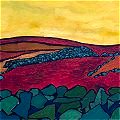Black Irish Reunion in SE Missouri
The Black Irish, or the Northern Cherokee Nation as you may know them.
Glinda Ladd-Seabaugh of Cape Girardeau, a member of the Northern Cherokee Nation for over 12 years, takes Cherokee presentations around to schools to teach about the tribe, and disavow children of the stereotypes they only know.
“We were not savages, didn’t live in tepees and printed copies of the Bible in Cherokee and English. In 1839, we were an affluent group living in three- and four-story mansions.”
“Many of our ancestors chose slavery to keep their freedom,” Ladd-Seabaugh said. “My own relatives in Bollinger County in the 1700s lied about who they were so they wouldn’t lose their property. They would call themselves Black Dutch or Black Irish.”
See More History on Irish KC:
• Anseo is Ansiúd
• How Derry Began
• The Greatest Day to be Irish in Kansas City

 Eolaí gan Fhéile:
Eolaí gan Fhéile:











“Black Irish” actually takes on many meanings in this part of the world.
Here in the Arkansas Ozarks the term is also associated with the Cherokee but for different reasons.
In 1838 the “Trail of Tears” began with the Cherokee Nation
being forcibly removed from the East Coast and relocated to Oklahoma. The “Trail of Tears” led through the Ozarks and on that first forced march the winter was extremely brutal and they found themselves having to “hole up” in the Northern Ozarks around what would now be Stone and Izzard Counties,
right there on the border with Missouri.
That winter, thousands of the Cherokee “escaped” along with the help of local Ozark dwellers, no small portion of whom were Irish immigrants.
The march went on in the spring and the “escapees” were left behind. Many of the Cherokee women married Irish men in the Ozarks and vice-versa. Irish daughters would marry Cherokee men.
It was the children of these mixed unions that would come to be referred to as the “Black Irish” in Arkansas.
They were also called “The Lost Cherokee” because the people who were hired to move the Cherokee lied about how many were lost along the way and, when they got to Oklahoma, claimed that everyone arrived so they would get paid in full.
They were basically being paid as if they were moving cattle and “the head count” was faked.
So to this day it is hard for many Arkansas Cherokees or their
descendants to trace their history. Official government documents show them as having arrived in Oklahoma when that actually never happened. Most of the “Black Irish” in Arkansas are also “The Lost Cherokee”.
Scott Moye, the amazing Irish Button Box ( and Irish whistle and fiddle ) player here in Arkansas, whom I had the pleasure to share the Atrium stage with at last year’s Kansas City Irish Festival, was born and raised in NE Arkansas. He is one-half Cherokee and one-half Irish.
Yes it’s a much used and abused phrase, the most common usage of it in Ireland pertaining to the popular myth of the masses conceived by the Spanish Armada
Every time I read or hear something about the treatment of the indigenous people in North America, I become apoplectic with rage, which is probably why I read less of it than I should. Native American is not a term I feel comfortable with, but maybe that’s a European perspective.
The story of the Choctaw people’s engagement with the Irish famine is worth repeating, and maybe some of us should do so. It might help us to have a better understanding of the current influx of African people into Ireland.